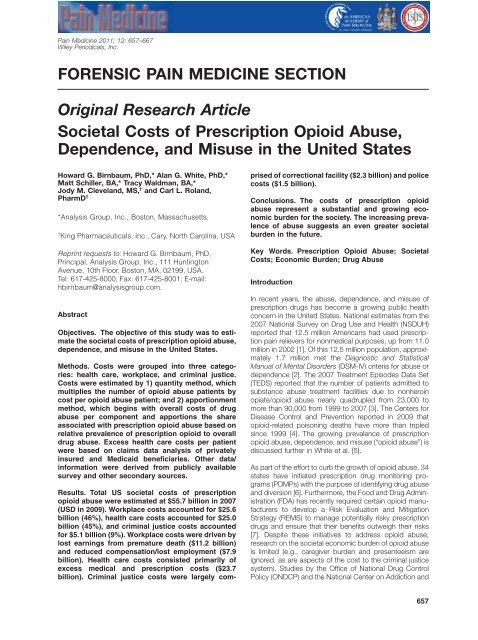The Economic Consequences of Opioid Addiction in America
The Economic Consequences of Opioid Addiction in America
The Economic Consequences of Opioid Addiction in America
You also want an ePaper? Increase the reach of your titles
YUMPU automatically turns print PDFs into web optimized ePapers that Google loves.
Pa<strong>in</strong> Medic<strong>in</strong>e 2011; 12: 657–667<br />
Wiley Periodicals, Inc.<br />
FORENSIC PAIN MEDICINE SECTION<br />
Orig<strong>in</strong>al Research Article<br />
Societal Costs <strong>of</strong> Prescription <strong>Opioid</strong> Abuse,<br />
Dependence, and Misuse <strong>in</strong> the United Statespme_1075 657..667<br />
Howard G. Birnbaum, PhD,* Alan G. White, PhD,*<br />
Matt Schiller, BA,* Tracy Waldman, BA,*<br />
Jody M. Cleveland, MS, † and Carl L. Roland,<br />
PharmD †<br />
*Analysis Group, Inc., Boston, Massachusetts,<br />
†<br />
K<strong>in</strong>g Pharmaceuticals, Inc., Cary, North Carol<strong>in</strong>a, USA<br />
Repr<strong>in</strong>t requests to: Howard G. Birnbaum, PhD,<br />
Pr<strong>in</strong>cipal, Analysis Group, Inc., 111 Hunt<strong>in</strong>gton<br />
Avenue, 10th Floor, Boston, MA, 02199, USA.<br />
Tel: 617-425-8000; Fax: 617-425-8001; E-mail:<br />
hbirnbaum@analysisgroup.com.<br />
Abstract<br />
Objectives. <strong>The</strong> objective <strong>of</strong> this study was to estimate<br />
the societal costs <strong>of</strong> prescription opioid abuse,<br />
dependence, and misuse <strong>in</strong> the United States.<br />
Methods. Costs were grouped <strong>in</strong>to three categories:<br />
health care, workplace, and crim<strong>in</strong>al justice.<br />
Costs were estimated by 1) quantity method, which<br />
multiplies the number <strong>of</strong> opioid abuse patients by<br />
cost per opioid abuse patient; and 2) apportionment<br />
method, which beg<strong>in</strong>s with overall costs <strong>of</strong> drug<br />
abuse per component and apportions the share<br />
associated with prescription opioid abuse based on<br />
relative prevalence <strong>of</strong> prescription opioid to overall<br />
drug abuse. Excess health care costs per patient<br />
were based on claims data analysis <strong>of</strong> privately<br />
<strong>in</strong>sured and Medicaid beneficiaries. Other data/<br />
<strong>in</strong>formation were derived from publicly available<br />
survey and other secondary sources.<br />
Results. Total US societal costs <strong>of</strong> prescription<br />
opioid abuse were estimated at $55.7 billion <strong>in</strong> 2007<br />
(USD <strong>in</strong> 2009). Workplace costs accounted for $25.6<br />
billion (46%), health care costs accounted for $25.0<br />
billion (45%), and crim<strong>in</strong>al justice costs accounted<br />
for $5.1 billion (9%). Workplace costs were driven by<br />
lost earn<strong>in</strong>gs from premature death ($11.2 billion)<br />
and reduced compensation/lost employment ($7.9<br />
billion). Health care costs consisted primarily <strong>of</strong><br />
excess medical and prescription costs ($23.7<br />
billion). Crim<strong>in</strong>al justice costs were largely comprised<br />
<strong>of</strong> correctional facility ($2.3 billion) and police<br />
costs ($1.5 billion).<br />
Conclusions. <strong>The</strong> costs <strong>of</strong> prescription opioid<br />
abuse represent a substantial and grow<strong>in</strong>g economic<br />
burden for the society. <strong>The</strong> <strong>in</strong>creas<strong>in</strong>g prevalence<br />
<strong>of</strong> abuse suggests an even greater societal<br />
burden <strong>in</strong> the future.<br />
Key Words. Prescription <strong>Opioid</strong> Abuse; Societal<br />
Costs; <strong>Economic</strong> Burden; Drug Abuse<br />
Introduction<br />
In recent years, the abuse, dependence, and misuse <strong>of</strong><br />
prescription drugs has become a grow<strong>in</strong>g public health<br />
concern <strong>in</strong> the United States. National estimates from the<br />
2007 National Survey on Drug Use and Health (NSDUH)<br />
reported that 12.5 million <strong>America</strong>ns had used prescription<br />
pa<strong>in</strong> relievers for nonmedical purposes, up from 11.0<br />
million <strong>in</strong> 2002 [1]. Of this 12.5 million population, approximately<br />
1.7 million met the Diagnostic and Statistical<br />
Manual <strong>of</strong> Mental Disorders (DSM-IV) criteria for abuse or<br />
dependence [2]. <strong>The</strong> 2007 Treatment Episodes Data Set<br />
(TEDS) reported that the number <strong>of</strong> patients admitted to<br />
substance abuse treatment facilities due to nonhero<strong>in</strong><br />
opiate/opioid abuse nearly quadrupled from 23,000 to<br />
more than 90,000 from 1999 to 2007 [3]. <strong>The</strong> Centers for<br />
Disease Control and Prevention reported <strong>in</strong> 2009 that<br />
opioid-related poison<strong>in</strong>g deaths have more than tripled<br />
s<strong>in</strong>ce 1999 [4]. <strong>The</strong> grow<strong>in</strong>g prevalence <strong>of</strong> prescription<br />
opioid abuse, dependence, and misuse (“opioid abuse”) is<br />
discussed further <strong>in</strong> White et al. [5].<br />
As part <strong>of</strong> the effort to curb the growth <strong>of</strong> opioid abuse, 34<br />
states have <strong>in</strong>itiated prescription drug monitor<strong>in</strong>g programs<br />
(PDMPs) with the purpose <strong>of</strong> identify<strong>in</strong>g drug abuse<br />
and diversion [6]. Furthermore, the Food and Drug Adm<strong>in</strong>istration<br />
(FDA) has recently required certa<strong>in</strong> opioid manufacturers<br />
to develop a Risk Evaluation and Mitigation<br />
Strategy (REMS) to manage potentially risky prescription<br />
drugs and ensure that their benefits outweigh their risks<br />
[7]. Despite these <strong>in</strong>itiatives to address opioid abuse,<br />
research on the societal economic burden <strong>of</strong> opioid abuse<br />
is limited (e.g., caregiver burden and presenteeism are<br />
ignored, as are aspects <strong>of</strong> the cost to the crim<strong>in</strong>al justice<br />
system). Studies by the Office <strong>of</strong> National Drug Control<br />
Policy (ONDCP) and the National Center on <strong>Addiction</strong> and<br />
657

















